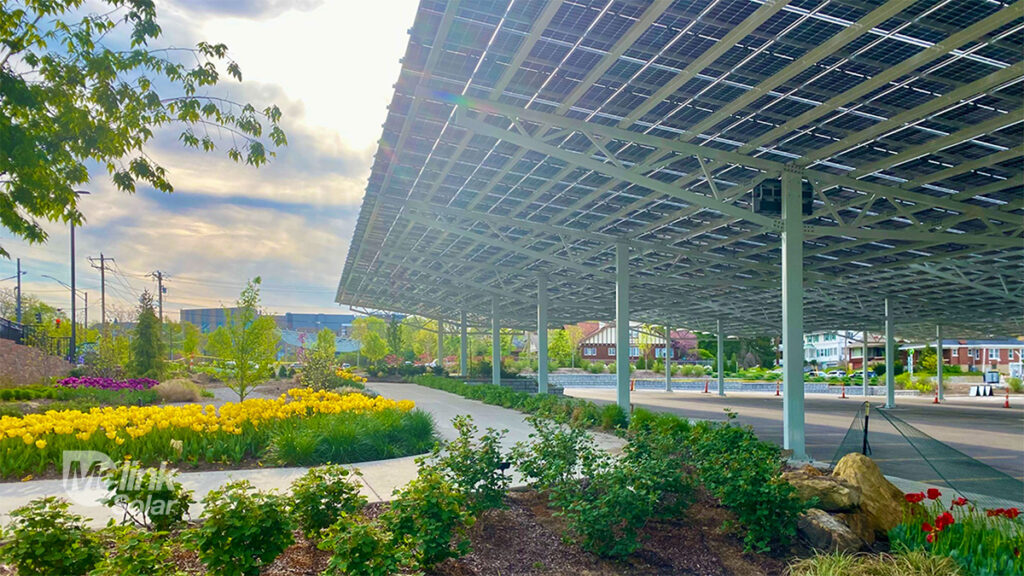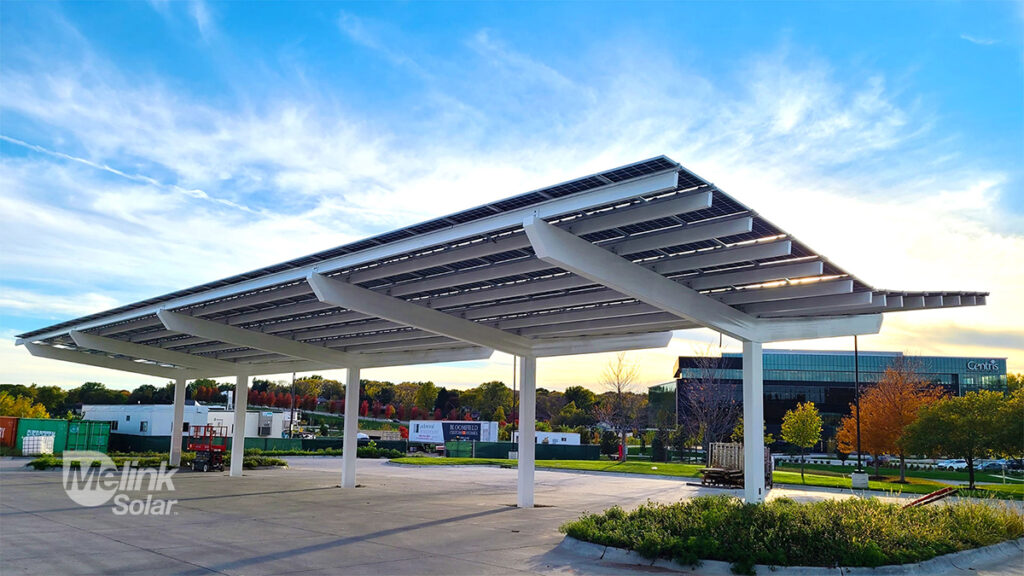How do solar parking canopies work, and what makes them different from other mounting types?
If your site lacks open land or available rooftop space, or if you’re looking for a highly visible, multi-functional solar solution, a parking canopy system could be the ideal fit. Solar canopies are overhead structures that install solar panels above parking lots or other paved areas, turning underused space into clean energy while providing shade, comfort, and often EV charging capabilities.
While more expensive than other mounting types, canopies offer unique value, especially for customer-facing businesses, schools, universities, and corporate campuses looking to combine sustainability with user experience.
Why Choose a Solar Canopy?
- Efficient Land Use: Transforms underutilized parking areas into productive energy-generating spaces without sacrificing valuable real estate.
- Vehicle Protection: Provides shade and shelter, reducing vehicle exposure to sun and inclement weather, enhancing comfort for drivers and passengers.
- Enhanced Public Image: Demonstrates a visible commitment to sustainability, potentially improving brand reputation and public relations.
- Potential for EV Integration: Can be designed to incorporate electric vehicle charging stations, promoting the adoption of clean transportation.
Many organizations use canopies to maximize public visibility of their sustainability efforts or take advantage of underutilized paved space.
Common Canopy Structure Types
Canopy Type: Tee-Style Canopies #

Tee-style canopies are the most cost-effective solution for businesses looking to harness solar energy while utilizing parking or outdoor spaces. Supported by a durable I-beam post, these canopies feature a single steel beam at the top, forming a structure that resembles the letter “T.” Mounted to this beam are Z-shaped or tubular purlins that securely hold the solar panels in place. The simplicity of this design reduces material and installation costs, making it an economical choice for large-scale projects. Tee-style canopies provide reliable shading, weather protection, and clean energy generation without compromising on functionality or efficiency.
Canopy Type: Truss-Style Canopies #

Truss-style solar canopies offer enhanced strength and flexibility, making them an excellent choice for projects requiring longer spans or greater weight-bearing capacity. These canopies use steel tubes instead of traditional I-beam posts and incorporate a latticework of steel trusses at the top of the structure. This design not only increases structural integrity but also allows for larger coverage areas with fewer support columns, maximizing the usable space beneath the canopy.Truss-style canopies are particularly suitable for regions with heavy snowfall or high wind loads, as their robust construction can withstand substantial environmental stresses.
Canopy Type: Inverted Canopy Designs #

In situations where parking rows run north-south, an inverted design can help boost energy production by optimizing east–west sun exposure throughout the day.
- Panels slope inward, forming a shallow “V” shape overhead
- Allows morning and afternoon sun to strike both canopy planes more directly
- Available in tee, truss, or long-span configurations
- Often chosen for aesthetic or architectural reasons
Inverted designs may produce slightly more energy in some climates, but also add to steel cost and structural complexity.
Canopy Options Summarized:
Tee-Style Canopies
The most economical and straightforward design.
- Built around a central steel “T” post and beam
- Uses tubular or Z-purlins to mount the solar modules
- Ideal for flat or gently sloped parking lots
- Clean, open layout that allows for flexible vehicle flow
Truss-Style Canopies
Designed for strength, snow loads, and long spans.
- Incorporates a webbed steel truss to support heavier structural loads
- Reduces the number of columns, improving navigation and parking visibility
- Well-suited for northern climates or wind-exposed sites
- Can be engineered to support branding, signage, or lighting
Inverted Canopies
Optimized for east–west solar exposure and architectural impact.
- Panels form a shallow “V” shape, sloping inward
- Useful for north–south parking layouts, maximizing early morning and late afternoon sunlight
- Offers a modern, symmetric aesthetic
- Can be designed with long spans or multi-bay coverage
Comparison: Canopy Structure Types
| Feature | Tee-Style | Truss-Style | Inverted |
| Steel Usage | Moderate | High | Highest |
| Visual Appeal | Industrial, simple | Strong, architectural | Sleek, symmetric |
| Best Use Case | Budget-friendly projects | Snow/wind-prone areas | High-visibility or north–south lots |
| Span Capacity | Standard | Extended | Flexible |
| Energy Output | Standard | Standard | Slightly higher (in some cases) |
Key Design Considerations
Solar canopy projects involve more complex engineering and permitting than rooftop or ground-mounted systems. Before construction begins, Melink Solar assesses:
- Steel sizing and structural load requirements (including seismic, snow, wind)
- Minimum height and vehicle clearance standards
- Stormwater runoff and drainage controls
- Trenching and electrical conduit routing for interconnection
- EV charger placement and utility interconnection
- Fire lane and code-compliance clearances
Canopies may require additional time for permitting, geotechnical analysis, and coordination with civil and structural engineers.
Case Study: Cincinnati Zoo Solar Canopy
In 2011, the Cincinnati Zoo & Botanical Garden, in partnership with Melink Solar, completed a 1.56 MW solar canopy across 7 acres of parking. It provides shade for guests and generates enough clean energy to offset 20% of the zoo’s annual usage, producing over 8.9 million kWh per year.This landmark project remains one of the most visible and impactful examples of solar canopy use in the U.S.
Recognized nationally for combining education, sustainability, and design—all while delivering utility savings and public goodwill.
What Do Canopies Cost, and Are They Worth It?
Canopies typically carry a higher cost per watt than rooftop or ground-mount systems due to:
- Structural steel requirements
- Foundations, columns, and conduit runs
- Aesthetic finishes (paint, galvanized coatings)
- Longer permitting and design timelines
That said, canopies offer non-energy value that’s hard to match:
- Brand exposure and signage opportunities
- Covered parking as a property amenity
- EV-readiness that supports future infrastructure
- Additional federal tax credits under the Inflation Reduction Act when paired with domestic materials or installed in eligible zones
Want to compare the costs of ground-mounted systems to rooftop or canopy options?
See Section 4.1: What Determines the Cost of a Commercial Solar Project?
Curious about the typical lifespan and maintenance for ground-mounted equipment?
Explore Section 3.2: How Long Will My Solar Equipment Last, and What Do Warranties Cover?
